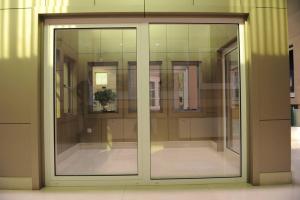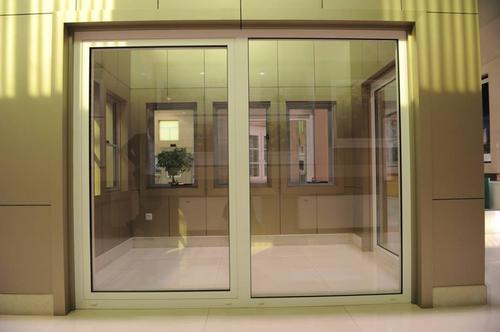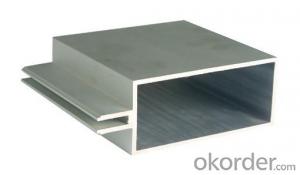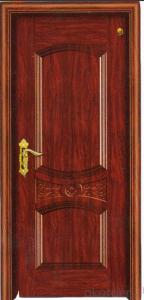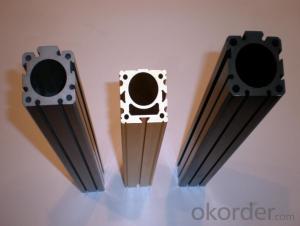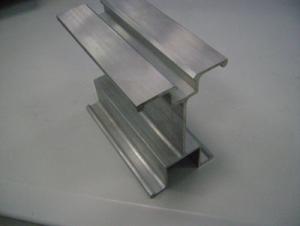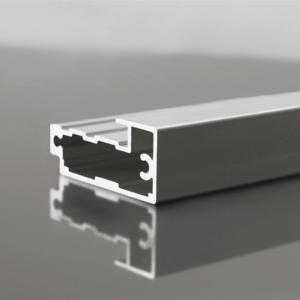Aluminum Window and Door with White Paint - Aluminum Profiles for LED Strips
- Loading Port:
- China Main Port
- Payment Terms:
- TT OR LC
- Min Order Qty:
- -
- Supply Capability:
- -
OKorder Service Pledge
OKorder Financial Service
You Might Also Like
Material introduction
1) 6063-T5 national standard aluminium profile .
2) 95% pure
3) Lengths: 3-6meters, or based on customer requirement
4) Recycling material which is helpful for environment protection
5) Flexible size and shape based on customer's design
Recommend application
1) Exterior of building, pillar, terrace, balcony
2) Airport / bus station, auditorium, music hall, sports center, reception hall
3) Window and door rails and frames
4) Furniture wardrobe rails, frams and kitchen cabinet handles
5) Automatic equipment, profile parts for industrial machines
Technical requirements
1.Standard: GB/75237-2004,Q/320281/PDWD-2008
2.Certification: ISO9001
3.OEM service offered
- Q: How do you protect aluminum profiles from scratching or damage?
- There are several ways to protect aluminum profiles from scratching or damage. Firstly, applying a protective coating or finish is a common method. This can be done by using paints, lacquers, or powder coatings that create a barrier between the aluminum surface and external elements. These coatings not only enhance the appearance but also provide protection against scratches, corrosion, and other damages. Secondly, using protective film or tape is an effective temporary solution. These films or tapes can be applied directly onto the aluminum profiles, acting as a protective layer. These films are often transparent and can be easily peeled off once the profiles are installed or ready for use. Another technique is to handle and transport the aluminum profiles with care. This involves using proper handling equipment, such as gloves, to avoid direct contact with the surface. Additionally, using protective packaging materials, such as bubble wrap or foam, can provide cushioning during transportation to prevent scratches or dents. It is also important to regularly clean and maintain the aluminum profiles. Dust, dirt, and debris can act as abrasives and cause scratches over time. Regularly cleaning with a soft cloth or sponge and mild detergent can help remove these particles and maintain the profile's appearance. Lastly, implementing proper storage techniques is crucial. Storing aluminum profiles in a dry and clean environment, away from sharp objects or heavy items, can minimize the risk of scratching or damage. Using racks or shelves with protective padding can also provide an additional layer of protection. By following these measures, aluminum profiles can be effectively protected from scratching or damage, ensuring their longevity and maintaining their aesthetic appeal.
- Q: What are the standard dimensions and sizes of aluminum profiles?
- The dimensions and sizes of aluminum profiles can vary depending on the specific application and industry. However, there are commonly used dimensions and sizes that are widely adopted across industries. Aluminum profiles are available in various shapes, including angles, channels, tubes, and bars. These profiles have dimensions that range from small to large, with measurements based on width, height, and thickness. For instance, aluminum angle profiles typically have widths and heights ranging from 1/2 inch to 8 inches, with thicknesses ranging from 1/16 inch to 1/2 inch. Aluminum channel profiles have widths from 1/2 inch to 12 inches, heights from 1/2 inch to 3 inches, and thicknesses from 1/16 inch to 1/4 inch. Aluminum tube profiles come in different outer diameters, ranging from 1/8 inch to 6 inches, with wall thicknesses from 1/32 inch to 1/4 inch. Aluminum bar profiles usually have widths from 1/8 inch to 12 inches, heights from 1/8 inch to 4 inches, and thicknesses from 1/16 inch to 1/2 inch. It's important to note that these dimensions and sizes serve as a general guideline, and custom dimensions or sizes may be required for specific applications. Furthermore, different countries or regions may have their own standards and variations in aluminum profile dimensions and sizes. Therefore, it's advisable to consult with manufacturers or suppliers to determine the specific dimensions and sizes that meet your requirements.
- Q: Can aluminum profiles be used in lightweight construction applications?
- Aluminum profiles are definitely applicable in lightweight construction. They possess a lightweight and versatile nature that brings numerous advantages to construction projects. With a high strength-to-weight ratio, structures can be built with less material yet still maintain strength and durability. This makes aluminum profiles an ideal choice for lightweight construction where weight reduction is crucial. Various construction projects, including building facades, interior partitions, roofing systems, and structural frameworks, commonly utilize aluminum profiles. They are particularly favored in industries such as aerospace, automotive, and marine where reducing weight is of utmost importance. Additionally, aluminum profiles exhibit excellent resistance to corrosion, making them suitable for outdoor and high-moisture environments. Their high malleability allows for easy fabrication into different shapes and sizes, enabling customized designs and simple installation. Moreover, aluminum is an eco-friendly material as it can be recycled infinitely without compromising its properties. To sum up, the widespread use of aluminum profiles in lightweight construction stems from their lightweight nature, strength, durability, corrosion resistance, malleability, and environmental benefits.
- Q: Are aluminum profiles suitable for historical or heritage restoration projects?
- Historical or heritage restoration projects can benefit from the use of aluminum profiles. Aluminum, being a versatile material, offers numerous advantages for such projects. Firstly, it can be manufactured to replicate traditional architectural features and designs, seamlessly integrating and preserving the historical aesthetics. In addition, aluminum is lightweight, making it easier to handle and install, especially in complex or intricate restoration projects. It is also highly durable and resistant to corrosion, which is vital for maintaining the structural integrity and longevity of historical buildings or structures. Moreover, aluminum profiles can be easily customized and fabricated to meet the specific requirements of historical restoration projects. They can be shaped, cut, and finished to resemble the original architectural elements, such as windows, doors, trim, or decorative features. Furthermore, aluminum profiles offer excellent thermal performance, improving energy efficiency and insulation in restored buildings. This leads to reduced energy consumption, lower heating or cooling costs, and enhanced overall comfort. Although wood or steel have been commonly used in historical restoration projects, aluminum profiles provide a contemporary alternative that combines aesthetic appeal, durability, and sustainability. However, it is crucial to ensure that the use of aluminum profiles aligns with the preservation guidelines and regulations of the specific historical or heritage project. In conclusion, aluminum profiles are a suitable choice for historical or heritage restoration projects due to their versatility, durability, lightweight nature, customization options, and energy efficiency. They successfully blend modern functionality with historical aesthetics, contributing to the preservation and revitalization of our architectural heritage.
- Q: This question asks about the various uses of aluminum profiles in the construction of buildings.
- <p>Aluminum profiles have a wide range of applications in building construction due to their strength, durability, and lightweight properties. They are used in window and door frames, curtain walls, and structural glazing systems for their high strength-to-weight ratio and resistance to corrosion. Additionally, aluminum profiles are utilized in the construction of balconies, handrails, and stairways for their ability to withstand harsh weather conditions. They are also employed in the fabrication of modular building systems and prefabricated components, offering ease of assembly and design flexibility. Furthermore, aluminum profiles are used in the construction of solar panel mounting systems and facades due to their thermal conductivity and ability to support heavy loads.</p>
- Q: This question asks for a list of various aluminum profiles that are utilized in the construction of building facades and cladding systems.
- <p>Aluminum profiles for facades and cladding systems come in various types, each serving specific purposes in construction. Common types include: 1. <strong>Aluminum Extrusions</strong>: Used for structural support and can be customized for specific design requirements. 2. <strong>Aluminum Channels</strong>: Often used for attaching panels or as a part of the support structure. 3. <strong>Aluminum Angles</strong>: Provide corner support and reinforcement. 4. <strong>Aluminum Flat Bars</strong>: Used for horizontal or vertical support in facade systems. 5. <strong>Aluminum Tubes</strong>: Can be used as a decorative element or for structural reinforcement. 6. <strong>Aluminum Louvers</strong>: Designed for sun shading and ventilation. 7. <strong>Aluminum Panels</strong>: Can be flat or profiled, used for the outer layer of the facade. 8. <strong>Aluminum Trims and Mouldings</strong>: Used for finishing and detailing around windows, doors, and edges. Each type is chosen based on the architectural design, structural requirements, and aesthetic preferences.</p>
- Q: What are the water-resistant properties of aluminum profiles?
- Because of their natural oxide layer, aluminum profiles have excellent water-resistant properties. This layer acts as a protective barrier, preventing water molecules from penetrating and stopping corrosion. Furthermore, various surface treatments like anodizing, powder coating, or painting can enhance aluminum profiles even more, providing an extra layer of defense against water damage. These treatments not only improve the profiles' appearance but also increase their resistance to water, making them suitable for outdoor use or in areas with high humidity. Additionally, aluminum profiles are inherently structurally sound and dimensionally stable, even in wet environments. This makes them a dependable choice for water-resistant applications such as windows, doors, and façade systems.
- Q: What are the different surface protection methods for aluminum profiles?
- There are several surface protection methods for aluminum profiles, including anodizing, powder coating, painting, and mechanical finishes. Anodizing is a popular method that creates a protective oxide layer on the surface, providing corrosion resistance and enhancing the appearance. Powder coating involves applying a dry powder onto the profile, which is then cured to create a durable and decorative finish. Painting is another option, where a liquid paint is applied and cured to protect the surface. Mechanical finishes involve processes like brushing or polishing to achieve a desired texture or appearance while still protecting the aluminum profile.
- Q: and I know the meaning of 125MN is 12500 tons. I want to know if 125MN is a English an abbreviation of the word, if it is, then what is he, if he is not that what is the meaning?
- MN is an international unit, said the bull"125MN's extruder is 12500T's extruderBloomberg metal Forum
- Q: Can aluminum profiles be used for electrical bus ducts?
- Indeed, electrical bus ducts can be constructed using aluminum profiles. Within the electrical industry, aluminum is widely employed as it possesses exceptional conductivity and lightweight characteristics. Its remarkable electrical conductivity plays a vital role in efficiently transmitting electrical power. Furthermore, aluminum profiles exhibit durability, resistance to corrosion, and the ability to endure high temperatures, rendering them suitable for diverse industrial applications. Nonetheless, it is crucial to carefully assess the project's unique requirements and regulations in order to ascertain that the aluminum profiles conform to the essential electrical and safety standards.
Send your message to us
Aluminum Window and Door with White Paint - Aluminum Profiles for LED Strips
- Loading Port:
- China Main Port
- Payment Terms:
- TT OR LC
- Min Order Qty:
- -
- Supply Capability:
- -
OKorder Service Pledge
OKorder Financial Service
Similar products
Hot products
Hot Searches
Related keywords
